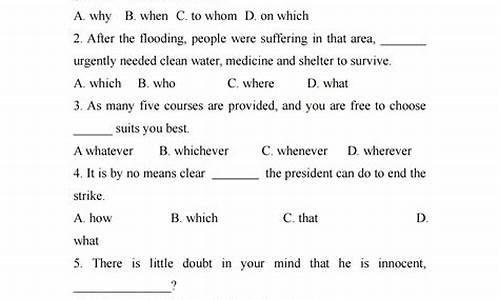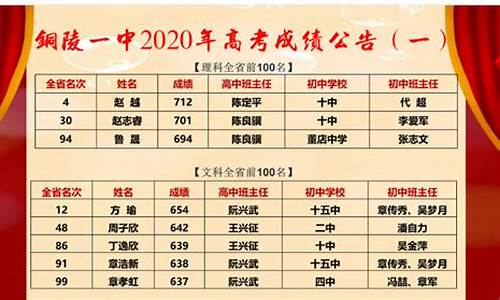您现在的位置是: 首页 > 教育科技 教育科技
高考英语成分_高考英语各个部分占分
tamoadmin 2024-05-29 人已围观
简介1.高考英语难句解析?2.分析英语句子成分的方法3.英语句子结构分析,because of在这个句子做什么成分?4.高考英语句子成分5.高考英语知识要点总结6.分析一下2011年安徽高考英语卷中的33题的句子成分一级结构: 首先省略了主语。二级结构:复合谓语,Work together ,and make sure 加了逗号的原因是因为被前面很长的介词短语给间隔开了,避免歧义。三级结构:前
1.高考英语难句解析?
2.分析英语句子成分的方法
3.英语句子结构分析,because of在这个句子做什么成分?
4.高考英语句子成分
5.高考英语知识要点总结
6.分析一下2011年安徽高考英语卷中的33题的句子成分

一级结构: 首先省略了主语。
二级结构:复合谓语,Work together ,and make sure 加了逗号的原因是因为被前面很长的介词短语给间隔开了,避免歧义。
三级结构:前半段,by communicating with other vessels 介词短语作状语;后半段,that引导的宾语从句。
四级结构:在that引导的宾语从句中,你分析的基本是对的。
高考英语难句解析?
主谓宾,定状补
主干枝叶分清楚
主干成分主谓宾
枝叶成分定状补
定语必居主宾前
谓前为状谓后补
学语文,有口诀(基本语序、不包括倒装)
主谓宾、定状补,主干枝叶分清楚。
定语必居主宾前,谓前为状谓后补。
状语有时位主前,逗号分开心有数。
基本成分主谓宾,连带成分定状补。定语必居主宾前,谓前为状谓后补。
六者关系难分辨,心中有数析正误。什么谁称主,做是怎样才充谓;
宾语动支配,回答谓语什么谁。前置状语目(的)时(间)地(点),
意义不变能复位。补语从后说前谓,定语才和后宾配。介宾短语多状补,
不能充当宾主谓。的定地状与得补,语言标志定是非。
名词:
人和事物各有名,万千名目可辨清。表示名称即名词,具体抽象有不同。
时间空间和地点,方向位置有专称。主宾定谓都可作,名词具有多功能。
动词:
世间万物皆运动,于是动词相应生。行为动作和发展,存在消失与变更。
心理活动及判断,一概可作谓语用。能愿趋向两动词,配合谓语意更明。
形容词:
人有特征物有形,修饰动名靠形容。事态动作有性状,描摹性状用形容。
形容词语极丰富,准确修饰需深功。形容词语功能多,主要充当状谓定。
数词:
数词即为表数目,确数概数和序数。确数包括整分倍,不定数目是概数。
整数前加老第初,排列顺序是序数。分数倍数表增加,减少只能用分数。
量词:
表示单位量词全,单位各异按习惯。事物行动作统计,物量动量分两款。
量词数词相结合,数量短语功能全。动量短语居动后,物量短语在名前。
代词:
代词代替人事物,按照作用分三族。人称代词我你他,咱们自己和大家。
疑问代词谁什么,进地性状数如何。提示代词这和那,每名某另别其它。
副词:
副词修饰动与形,范围程度与时间。肯否估计与情态,语气频率用法全。
稍微没有全都偏,简直仅仅只永远,已经曾经就竟然,将要立刻刚偶然,
渐渐终于决忽然,难道连续又再三,也许必须很非常,最太十分更马上,
越极总挺常常再,屡次一定也不还。时名副名看加在,名前可加副不来。
前很后名都不行,单独回答更不能。
介词:
自从以当为按照,由于对于为了到;和跟把比在关于,除了同对向往朝;
用在名词代词前,修饰动形要记牢。
助词:
结构助词的地得,时态助词着了过,语气助词啊吧呢,他词后边附加义。
连词:
成分连词难分辨,换位不变才是连
英语的是在是没找到什麽、不过我觉得这个可能会有用的~~
中国人学英语最方便的一点就是,在简单句中,特别是刚刚开始学习英语的阶段,两种语言的句子结构很相似:
英语句子结构:(定语)主语+谓语+(定语)宾语+状语。 My brother often speak English.
汉语句子结构:(定语)主语+状语+谓语+(定语)宾语。 我弟弟经常说英语。
两种语言都可以在名词前加定语。英语的状语位置比较灵活。
在复合句中,也就是用一句话来充当某个句子成分,就出现了从句(主语从句、定语从句、宾语从句、状语从句等),这时,汉语的句子结构没什么变化,英语最明显的不同就是“定语从句通常放在被修饰成分的后面”。
高考英语资料库编写组
语法复习一:句子成分;简单句、并列句和复合句
一、句子成分
(一)句子成分的定义:构成句子的各个部分叫做句子成分。句子成分有主要成分和次要成分;主要成分有主语和谓语;次要成分有表语、宾语、定语、状语、补足语和同位语。
(二)主语:主语是一个句子所叙述的主体,一般位于句首。但在there be结构、疑问句(当主语不疑问词时)和倒装句中,主语位于谓语、助动词或情态动词后面。主语可由名词、代词、数词、不定式、动名词、名词化的形容词和主语从句等表示。一句话语法: 主语由名词性的词来充当. 例如:
During the 1990s, American country music has become more and more popular.(名词)
We often speak English in class.(代词)
One-third of the students in this class are girls.(数词)
To swim in the river is a great pleasure.(不定式)
Smoking does harm to the health.(动名词)
The rich should help the poor.(名词化的形容词)
When we are going to have an English test has not been decided.(主语从句)
It is necessary to master a foreign language.(it作形式主语,真正的主语为后面的不定式)
(三)谓语:谓语说明主语所做的动作或具有的特征和状态。动词在句中作谓语,一般放在主语之后。一句话语法: 谓语由动词充当. 有很多同学在写作的时候容易犯的错误就是要么乱用be动词,要么句子没有谓语动词. 谓语的构成如下:
1、简单谓语:由一个动词或动词短语构成。如:He practices running every morning.
2、复合谓语:(1)由情态动词或其他助动词加动词原形构成。注意:这里面的动词原形非常重要. 如:You may keep the book for two weeks. He has caught a bad cold. (2)由系动词加表语构成。如:We are students.
(四)表语:表语用以说明主语的身份、特征和状态,它一般位于系动词(如be, become, get, look, grow, turn, seem等)之后。表语一般由名词、代词、形容词、分词、数词、不定式、动名词、介词短语、副词及表语从句表示。一句话语法: 表语使用形容词,不用副词! 例如:
Our teacher of English is an American.(名词)
Is it yours?(代词)
The weather has turned cold.(形容词)
The speech is exciting.(分词)
Three times seven is twenty one?(数词)
His job is to teach English.(不定式)
His hobby(爱好)is playing football.(动名词)
The machine must be out of order.(介词短语)
Time is up. The class is over.(副词)注意: 副词可以做表语的只有几个,非常简单,考试不考,所以上面说:表语使用形容词,不用副词! 我们所复习的语法直接针对高考,不是搞语法研究,这点请大家一定要记住.
The truth is that he has never been abroad.(表语从句)
(五)宾语:宾语表示动作的对象或承爱者,一般位于及物动词和介词后面。一句话语法:宾语由名词性的词充当,宾语分为动词宾语和介词宾语,分别构成动宾结构和介词结构,这点非常重要,务必要牢记.例如:
They went to see an exhibition(展览)yesterday.(名词)
The heavy rain prevented me form coming to school on time.(代词)
How many dictionaries do you have? I have five.(数词)
They helped the old with their housework yesterday.(名词化形容词)
He pretended not to see me.(不定式短语)
I enjoy listening to popular music.(动名词短语)
I think(that)he is fit for his office.(宾语从句)
宾语种类:(1)双宾语(间接宾语+直接宾语),例如:Lend me your dictionary, please.如果同学搞不清楚什么是双宾语,记下下面这个句子: give me a book.一人一物做宾语就是双宾语.说得白一点,双就是两个的意思.(2)复合宾语(宾语+宾补),例如:They elected him their monitor.
(六)宾语补足语:英语中有些及物动词,除有一个直接宾语以外,还要有一个宾语补语,才能使句子的意义完整。带有宾语补足语的一般句型为:某些及物动词(如make等+宾语+宾补)。宾补可由名词、形容词、副词、不定式、分词、介词短语和从句充当。一句话语法: 宾语补足语使用形容词,不用副词.例如:
His father named him Dongming.(名词)
They painted their boat white.(形容词)
Let the fresh air in.(副词)
You mustn’t force him to lend his money to you.(不定式短语)
We saw her entering the room.(现在分词)
We found everything in the lab in good order.(介词短语)
We will soon make our city what your city is now.(从句)
(七)定语:修饰名词或代词的词、短语或从句称为定语。一句话语法:定语使用形容词 定语可由以下等成分表示:
Guilin is a beautiful city.(形容词)
China is a developing country; America is a developed country.(分词)
There are thirty women teachers is our school.(名词)
His rapid progress in English made us surprised.(代词)
Our monitor is always the first to enter the classroom.(不定式短语)
The teaching plan for next term has been worked out.(动名词)
He is reading an article about how to learn English.(介词短语)
(八)状语:修饰动词、形容词、副词或整个句子(这个就叫状语,一句话语法: 状语用副词,不用形容词),说明动作或状态特征的句子成分,叫做状语。可由以下形式表示:
Light travels most quickly.(副词及副词性词组)
He has lived in the city for ten years.(介词短语)
He is proud to have passed the national college entrance examination.(不定式短语)
He is in the room making a model plane.(分词短语)
Wait a minute.(名词)
Once you begin, you must continue.(状语从句)
状语种类如下:
How about meeting again at six?(时间状语)(表示时间就是时间状语,那表示原因的呢? 对喽,就是原因状语)
Last night she didn’t go to the dance party because of the rain.(原因状语)
I shall go there if it doesn’t rain.(条件状语)
Mr Smith lives on the third floor.(地点状语)
She put the eggs into the basket with great care.(方式状语)
She came in with a dictionary in her hand.(伴随状语)
In order to catch up with the others, I must work harder.(目的状语)
He was so tired that he fell asleep immediately.(结果状语)
She works very hard though she is old.(让步状语)
I am taller than he is.(比较状语)
主语
主语表明这句话说的是谁和什么,主语主要由名词、代词或相当于名词的单词,短语或从句充当。
一. 名词作主语
David arrived last night. 大卫昨晚到达。
Pride goes before a fall. 骄必败。
二. 代词作主语
Who is speaking, please? (在电话中)请问您是谁?
That's OK. 这没问题。
三. 数词作主语
Two will be enough. 两个就够了。
Two-thirds of the workers are women. 三分之二的工人是女工。
四. ing形式作主语
Skating is good exercise. 溜冰是很好的运动。
Looking up all the new words in the dictionary took him a lot of time.
从字典里查所有的生词花费了他许多时间。
五. 不定式作主语
To translate this ideal into reality needs hard work.
把理想转变成现实需要辛勤的劳动。
六. 名词化的形容词作主语
The blind and the lame are well cared for in our country.
在我们国家,盲人和肢残人受到很好的照顾。
The unemployed usually lead a hard life.
失业的人生活一般很困难。
七. 短语作主语
How to do well is an important question.
如何把这件事做好是一个重要问题。
Early to bed and early to rise makes a man healthy.
早睡早起身体好。
八. 从句作主语
What has happened proves that our policy is right.
发生的一切证明我们的政策是对的。
Whether we'll go depends on the weather.
我们是否去要看天气。
谓语
谓语说明主语的动作或状态。谓语动词一般在主语之后。
Some children asked for cold drinks.
有些孩子要喝冷饮。
I shall go to see him tomorrow.
明天我要去看他。
I must ask her to teach me to swim.
我一定得请她教我游泳。
宾语
宾语一般用在及物动词的后面,表示行为动词所涉及的对象。
一. 名词作宾语
Show your passport, please.
请出示护照。
二. 代词作宾语
He didn't say anything.
她什么也没说。
三. 数词作宾语
How many do you want? - I want two.
你要几个?- 我要两个。
四. 名词化的形容词作宾语
They sent the injured to hospital.
他们把伤员送到医院。
五. 不定式或ing形式作宾语
The asked to see my passport.
他们要求看我的护照。
I enjoy working with you.
我和你们一道工作很愉快。
六. 从句作宾语
Did you write down what he said?
你把他的话记下了没有?
表语
表语是用来说明主语的身份、特征和状态的,它常位于联系动词(be, become, appear, seem等)之后。
一. 名词作表语
Africa is a big continent.
非洲是个大洲。
That remains a puzzle to me.
这对我还是个难题。
二. 代词作表语
What’s your fax number?
你的传真号是多少?
三. 形容词作表语
I feel much better today.
我今天感觉好多了。
四. 数词作表语
She was the first to learn about it.
她是第一个知道的人。
五. 不定式或ing形式作表语
Her job is selling computers.
她的工作是销售电脑。
Our next step was to get raw materials ready.
我们下一步是把原料准备好。
六. 介词短语作表语
The patient is out of danger.
病人脱险了。
I don’t feel at ease.
我感到不自在。
七. 副词作表语
The sun is up.
太阳升起来了。
I must be off now.
现在我得走了。
八. 从句作表语
This is what he said.
这就是他所说的话。
定语
形容词作定语
He's a tall man.
他是个高个子的男子。
<><><>
名词作定语
There are a lot of banana trees on the island.(banana)
岛上有许多香蕉树。
<><><>
数词作定语
Three thousand people watched the game.
三万人观看了球赛。
<><><>
限定词作定语
Many men are working there.
许多人在那儿工作。
<><><>
ing形式作定语
There is a swimming pool near our school.
我们学校附近有一个游泳池。
<><><>
ed分词作定语
frozen food 冷冻食品
fallen leaves 落叶
状语
副词作状语
Don't drive so fast.
别开得这么快。
<><><>
介词短语作地点状语
We live in Hangzhou.
我们住在杭州。
<><><>
名词作状语
The meeting lasted an hour.
会议开了一个小时。
主语+动词+形容词(双谓语)
接在动词之后对主语起着解释或描述作用的成分,叫作主补。
<><><>
形容词作主补
They married young.
他们结婚时还年轻。
He died happy.
他怀着幸福的心情死去。
No man is born wise.
没有生而知之。
<><><>
ed分词作主补
He came in drunk.
他走进来的时候醉醺醺的。
<><><>
名词作主补
He died a poor man.
他死时很穷。
He died a millionaire.
他死的时候是个百万富翁。
宾补
适用宾补的句型:
主语+谓语+宾语+宾补(S+V+O+OC)
宾补对宾语加以解释或描述。
<><><>
以下成分可以充当宾补:
名词,代词,形容词,副词,ing形式,ed分词,不定式,介词短语,名词性从句。
<><><>
名词作宾补
I consider him a gentleman.
<><><>
代词作宾补
Whom do you think me?
(Whom是宾补)
<><><>
形容词作宾补
Wash your hands clean.
<><><>
副词作宾补
I found him out.
<><><>
ing形式作宾补
They left me wait.
<><><>
ed分词作宾补
I heard my name called.
<><><>
不定式作宾补
I thought him to be a good man.
<><><>
介词短语作宾补
Make yourself at home.
分析英语句子成分的方法
Approach no closer than one hundred metres then stop the boat but keep the engine on
Approach one hundred meters
接近100公里
No closer than 100m祈使句
在文中
这句话应该是approach here,It is no more than a hundred meters
两个意思连起来的,他其实不符合语法,但是可以在文中使用,相当于口语的意思吧
英语句子结构分析,because of在这个句子做什么成分?
英语中有五种基本结构:
1. 主语+系动词(表示状态、性质、定义等)+表语
2. 主语+谓语动词(不及物,符号为 vi)+状语(时间、地点、原因、方式等)
3. 主语+谓语动词(及物动词,符号为 vt)+宾语(动作的承受者)
4. 主语+谓语动词(及物动词,符号为 vt)+某人+某物
5. 主语+谓语动词(及物动词,符号为 vt)+宾语+宾语补语(说明宾语的状态、动作、特征等,不可缺少,否则句意不完整)
注:1)任何正式语句都会符合这句型之一
2)各种句型里的动词都是各自独立的,不是说可以把任一个动词随便用在一个句型里,动词都有固定的用法,这要下功夫记忆,还有就是在语境中观察
3)分析复杂长句首先就是确定句型种类,关键是要敲定谓语动词,然后一一对应即可
4)长句、复杂句中每一个成分可能都不是单纯的词构成,这就需要长期的语言素养来辅助分析。Enjoy reading and learning!
高考英语句子成分
阅读是英语考试的重中之重,对英语阅读中的长难句理解是攻克阅读的有效方法。本文将着重讲解高考英语阅读真题中的长难句,希望提高大家阅读能力。
长难句解题思路
1. 首先寻找连词:连词包含并列连词,从属连词和关系词,并且依据连词将长句划分成短句;
2. 依据五大句型基本结构,判断短句的句子成分。注意区分谓语动词和非谓语动词(现在分词,动名词,过去分词,不定式),明确句子的谓语动词,剥离定语,状语,从而确定句子的基本结构。
第1句:时间状语从句,定语从句
When he returned, the boy was able to describe everything he had seen to the old man.
长句分析:
(1) when 引导的是时间状语从句;
(2) he had seen: 是一个定语从句,修饰先行词everything. 由于定语从句缺少宾语,因此省略了关系代词that。注意:先行词为不定代词everything时,关系代词不可使用Which;
(3) to the old man: 是做动词describe的宾语补足语;
(4) describe: 描述. Describe something to somebody : 向某人描述某物;
长句翻译:当他回来时,这个男孩能向老人描述他所看到的一切。
第2句:目的状语从句,宾语从句
The robot will have to have a certain way to receive the program so that it knows what it is to do.
长句分析:
(1) so that : 引导了一个目的状语从句,so 前面的句子是主句,that 后面的句子是目的状语从句;
(2) what 引导的是it knows的宾语从句,充当knows的宾语,it 是指示代词, 指代的是robot. What在宾语从句中充当do的宾语;
(3) have to : 不得不;劝告或建议时用;表示一定真实或肯定发生;
(4) have a way to do something : 拥有做某事的方法;
长句翻译:机器人必须有一个特定的方式来接收程序,这样它才能知道它要做什么。
第3句:定语从句
The company Jackie chose planned to employ only one person, but more than twenty people applied for the job.
长句分析:
(1) 并列连词but 链接了两并列句,前面一个句子为复合句;
(2) Jackie chose: 是一个定语从句,用来修饰先行词company的,由于定语从句中缺少宾语,所以该定语从句省略了关系代词that/which;
(3) choose: 选择;选取;挑选;决定;过去式:chose, 过去分词:chosen;
(4) plan to do something: 计划做某事;
(5) more than + 数量词: 超过,多余,相当于over;
(6) apply for : 提出申请;申请…职位;请求;
长句翻译:杰基选择的那家公司只打算雇用一个人,但有二十多个人申请了这份工作。
第4句:定语从句
Around this time, I started playing in a band with a Chinese man who became one of my best friends in Beijing.
长句分析:
(1)who引导了一个定语从句,修饰先行词a Chinese man;
(2)around : 大约, Around this time的大约这个时候;
(3) start doing something: 开始做某事;
长句翻译:大约在这个时候,我开始和一个中国人在一个乐队里演奏,他成了我在北京最好的朋友之一。
第5句:条件状语从句
I will tell you about it if no water is spilt when you reach here.
长句分析:
(1)主句是I will tell you about it, if 引导条件状语从句,when引导时间状语从句;
(2)tell somebody something = tell something to somebody: 告诉某人某事;
(3)spill: 溢出,涌出,蜂拥而出。过去式:spilt/spilled; 过去分词:spilt/spilled;
现在分词:spilling
长句翻译:如果你到这儿时没有水溅出来,我会告诉你的。
第6句:结果状语从句
The crocodile noticed that accident, so down he dived, and brought it up in his huge mouth.
长句分析:
(1) so 前后链接的两个句子表示因果关系,前面是因,后面是果;
(2) down he dived : 是将副词down 提到了主语的前面,用于强调down;
(3) dive: 猛冲;(头朝下)跳入水中;
(4) bring something up: 养育,抚养,养大;谈及;提出;呕吐;咳出;
长句翻译:鳄鱼注意到了这个意外,于是他潜了下去,用大嘴把它带上来。
第7句:原因状语从句,宾语从句,比较状语从句
Frost thinks kids don`t find the experience of being taught by smart machine as strange as older people because they have grown up in a time of computers and smart phones.
长句分析:
(1)because引导了一个原因状语从句,前面为主语,后面为从句;
(2)thinks 后面是宾语从句,该宾语从句省略了引导词that;
(3)as strange as: 引导了比较状语从句,第一个as 前面是主句,第二个as和后面是从句;
(4)在宾语从句kids don`t find , find 是谓语, the experience of … 是宾语且核心词是experience, strange是宾语补足语;
(5)Of being taught : being taught 是动名词的被动语态,做介词Of的宾语,因为孩子是被智能机器教,因此使用倍动态;
(6)in a time of : 在原因状语从句中充当grown up的时间状语。
词汇语法解析:
(1)find + somebody/something + 形容词:发现/认为/觉得 某人/某怎么样。形容词为宾语补足语,和宾语somebody/something 构成了复合宾语:
find the book interesting: 觉得这本书很有趣;
(2)动名词的被动语态:being done
The boy missed being hurt by the car.
这个男孩避免了被车伤到;
(3)grow up: 长大;
(4)in a time of : 在…时期
句子翻译:
Frost认为孩子们不像老人那样觉得被智能机器教导的经历和奇怪,因为他们生长在一个手机和电脑都很普及的时代。
第8句:非限定性定语从句
She and a group friends are using their program skill to create a new app called Food of Thought , which will allow parents, students and even kind-hearted strangers to donate money to lunch accounts for students who are in a nearby school.
长句分析:
(1)首先寻找连词,关系代词which引导了一个非限定性定语从句,修饰先行词Food of Thought . 因此which前面是主句,which后面是从句;
(2)在which引导的定语从句中,who 是关系代词,引导定语从句修饰先行词students, 并且在定语从句中做主语;
(3)在which引导的定语从句, which 是主语,allow 是谓语,to donate 是宾语补足语;
(4)在主句中出现三个动词 using, create, called, 需要区分谓语动词和非谓语动词。Using是谓语动词,to create是动词不定式做宾语补足语,Called 是过去分词短语做后置定语,修饰app;
重点词汇语法解析:
(1)donate: 赠送;献(血);捐献(器官);捐款,捐赠;
donation : 名词形式
donate something to somebody/something : 将…捐献给某人/某物;
(2)过去分词短语做后置定语:表示被动
a book written by Moyan :一本由莫言写的书;
a shopping mall opened last month: 一个上个月开张的购物商场;
(3)allow:允许
allow doing sth (allow to do 不正确)
allow sb to do sth
(4) kind-hearted: 仁慈的;善良的;宽容的;好心的;
(5)account:帐户;帐目;描述,报告;解释,说明;
open an account: 开银行账户;
keep detailed account: 记明细账;
He gave a detailed account of what happen on that night.
他详细的描述了那天晚上发生的事。
(6)account for :
(a)(数量,比例上)占…
Computer accounts for 5% of expense.
电脑占据开支的5%。
(b)说明,解释(原因,理由)
I can't account for why it happened.
我不能解释这件事为什么发生了。
长句翻译:
她和一群朋友正在利用他们的程序技巧,开发一款名为“思想食物”的新应用程序,该应用程序将允许家长、学生甚至善良的陌生人向附近学校学生的午餐账户捐款。
第9句:时间状语从句
Bees are now in danger and its number is going down every year largely because of human activity, while a third of the world's food production depends on this yellow and dark insect and other pollinators .
长句分析:
(1)首先寻找连词:and, while
(2)while 作为连词有两个作用,一是并列连词,表示转折,翻译成“然而”,二是从属连词,引导时间状语从句,翻译成“当…的时候”。根据题意可知,此时while 为并列连词;
(3)此长句的前半部分是由and连接的两个并列句,前半部分主语+系统词 + 介词短语构成的主系表结构,后半部分是现在进行时;because of 为介词短语做原因状语
重要词汇语法解析:
(1)in danger :垂危;处于危险中;处于危险之中;
(2)go down :下降;下沉;下降,降低;消退
(3)because of :因为,由于;
(4)production :生产,产量;
(5)depend on :依靠
it all depends: 看情况
(6) a third :三分之一, two thirds :三分之二:英语中分数由两部分组成”基数词 + 序数词”,当基数词大于1时,序数词要使用复数形式;
长句翻译:蜜蜂现在正处于危险之中,它的数量每年都在下降,这主要是由于人类的活动,而世界上三分之一的粮食产量都依赖于这种**和深色的昆虫和其他授粉者。
第10句:定语从句
In 1767, the British introduced new laws that increased the prices of all goods which were brought into America .
长句分析:
(1)首先寻找连词:that, which
(2)that 引导了定语从句,修饰先行词laws ,并且that 在定语从句中充当主语的成分;
(3)which 引导了定语从句,修饰先行词all goods, 并且which 在定语从句中做主语。注意:该定语从句是被动语态,系动词使用复数形式were, 是因为和先行词all goods 保持主谓一致;
(4)introduce: 介绍, 采纳,发起;
长句翻译:1767年,英国实行了新的法律,提高了所有带入美国的商品的价格。
第11句:原因状语从句,宾语从句
As the family have picked up the new lifestyle, they find that they can spend more time talking over meals, playing sports and doing all kinds of activities together.
长句分析:
(1)首先寻找连词:as, that;
(2)as 放在句首引导原因状语从句,从句后面是主句;
(3)在主句中,they 是主语,find是谓语动词,that引导宾语从句,做find的 宾语;
(4)在宾语从句中, can spend是符合谓语,time为宾语, talking, playing, doing 是由三个动名词构成的并列宾语补足语;
重点词汇解析:
(1)as可以引导愿意状语从句,翻译成“因为,由于”,语气没有because强烈,是对主句的一个附加说明,主句和从句之间没有必然的因果关系;
(2)pick up: 学会,养成;
(3)lifestyle: 生活方式;
(4)spend time (in) doing something ;
spend time on something :
花费时间做某事;
(5) all kinds of : 各种各样的
长句翻译:随着这个家庭开始接受新的生活方式,他们发现他们可以花更多的时间边吃饭边聊天,一起运动,一起做各种活动。
第12句:原因状语从句,定语从句
Those who choose to be happy must help others to find happiness , as the happiness of each has something to do with the happiness of all.
长句分析:
(1) 首先寻找连词:who, as;
(2) as 引导原因状语从句,as 前面的句子是主句;
(3)在主句中,who引导定语从句,修饰先行词those, 并且在定语从句中充当主;
(4)Must help 是主句的符合谓语,others 是宾语,to find happiness 是宾语补足语 ;
重点词汇解析:
(1)choose to do something: 选择做某事;
(2)help somebody ( to ) do something : 帮助某人做某事,to可以省略;
(3)happiness: 幸福;
(4)have something to do with : 和…有关系;
have nothing to do with: 和…无关系;
长句翻译:选择快乐的人必须帮助别人找到幸福,因为每个人的幸福都与所有人的幸福有关。
第13句:宾语从句
A survey made by Nelsen last year showed that kids are using mobile phone even before they got into their teens.
长句分析:
首先找出连词,有that, before ;
(1)that 引导宾语从句,做动词showed 的宾语。在此宾语从句中,before 引导时间状语从句,before前面是that宾语从句的主句;
(2)a survey 是整个复合句的主语,其中 made by Nelsen last year是过去分词短语做后置定语修饰survey;
重点词汇解析:
(1)survey : 调查;信息反馈;问卷调查;
(2)get into : 进入;穿上;成癖;陷于......;
(3)teens: 青少年;十多岁;青少年读物(13到19岁之间)
长句翻译:尼尔森去年做的一项调查显示,孩子们甚至在十几岁之前就开始使用手机。
第14句:强调句型,定语从句
Most of the time, it is not the problem you meet with but your reaction to the problem that creates the mess in your life.
长句分析:
(1)本句是一个强调句型,将it is , that去掉,重新组合句子:
Not the problem you meet with but your reaction to the problem creates the mess in your life.
(2)not ….but, 不是…而是…, 引导并列主语,the problem 和 your action to the problem ; creates 是谓语动词, the mess是宾语;
(3)you meet with 是一个定语从句修饰先行词problem,该定语从句省略了关系词that/which;
重点词汇语法解析:
(1)强调句型的结构:
It is(was) + 被强调的部分 + that(who) + 其他剩余部分。
该句型可以用来强调主语,宾语,状语,但是不可以强调谓语;
(2)强调句型判断标准:
去掉it is(was), that(who), 句子仍然是一个完整的句子。
(3)not…but…:不是…而是…: 链接两个并列主语时,谓语动词采用就近原则
Not you but I am wrong.
不是你错了,而是我错了。系动词使用am,依据I 来确定的;
(4)meet with: 遭遇,偶尔遇到;
(5) mess: 脏乱,不整洁,困境;
长句翻译:大多数时候,造成生活混乱的不是你遇到的问题,而是你对问题的反应。
第15句:宾语从句,让步状语从句,时间状语从句
She says although she always heard about bullying when she was in primary school, she never thought it would happen.
长句分析:
(1)本题是一个复合句,says是复合句的谓语动词,后面所有的部分都是says的宾语从句;
(2)该宾语从句也是一个复合句,其中although引导了让步状语从句,该状语从句中又包含了when引导了时间状语从句(3)宾语从句的主句是she never thought it would happen.其中it would happen 也是一个宾语从句,做谓语动词thought的宾语。
重点词汇解析:
(1)although 不可以和but连用,但是可以和yet, still 连用;
(2)hear about: 听说;
(3)bully: 恐吓;胁迫;伤害;
(4)primary school:小学
长句翻译:她说虽然她在小学的时候就听说过欺凌,但她从未想过会发生这种事。
第16句:让步状语从句,定语从句
Although happiness is a door that is always open, we are the ones who have to decide if we are going to walk through the door.
长句分析:
(1)although 引导让步状语从句;在该从句中that引导了一个定语从句,修习先行词a door, 并且在定语从句中充当主语的成分;
(2)在主句中,who引导定语从句,修饰先行词the ones,并且在定语从句中充当主语的成分;
(3)在定语从句who have to decide中,if引导宾语从句,做decide宾语;
长句翻译:虽然幸福是一扇永远敞开的门,但我们是决定是否要走进这扇门的人。
第17句:宾语从句,强调句型
He suddenly realized that in the past it was his laziness that made him poor and unhappy
长句分析:
1. Realized是主句的谓语动词,后面的that是一个宾语从句;
2. That引导的宾语从句是一个强调句型:去掉it wash…that…, 宾语从句的正常语序为his laziness made him poor and unhappy;
重要词汇语法解析:
1. suddenly :突然;忽然;猛然;骤然;
2. realize: 实现;意识到;领悟;理解;
3. laziness: 懒惰;
4. make + somebody + 形容词:使某人处于某种状态。形容词为宾语somebody的宾语补足语,对宾语进行补充说明
5. 强调句型的结构:
It is(was) + 被强调的部分 + that(who) + 其他剩余部分。该句型可以用来强调主语,宾语,状语,但是不可以强调谓语;
6. 强调句型判断标准:去掉it is(was), that(who), 句子仍然是一个完整的句子。
长句翻译:他意识到是他的懒惰使他过去贫穷不快乐。x数时候,不是你遇到的问题,而是你对问题的反应造成了你生活中的混乱。
第18句:宾语从句,定语从句,条件状语从句
The strangers were good at judging if the person they were looking at was tired, and if they were sleepy, their attractiveness score was low.
长句分析:
1. 首先寻找此长句中的连词:if, and。And前后为句子,因此and 链接了两个并列句;
2. 第一个if引导了宾语从句,充当judging的宾语,If 翻译成是否。且在此宾语从句中嵌套了一个定语从句they were looking at,该定语从句修饰先行词the person, 该定语从句缺少宾语,省略了关系词whom;
3. 第二个if引导的是条件状语从句,翻译成“如果”,主句为后面的their attractiveness score was low。
4. 注意:第二个if 并不是引导宾语从句,做judging的宾语。原因如下:如果if是judging的宾语从句,那么从The strangers到sleepy 是一个句子, 后面的their attractiveness score was low.是另一个句子,两个独立的句子之间应该使用并列连词链接。可是此处并没有连词,因此第二个If不是judging的宾语从句;
重点词汇 解析:
1. be good at: 擅长;
2. judge: 判断;
3. attractiveness:吸引力;魅力;吸引性;
长句翻译:陌生人善于判断对方是否累了,如果困了,他们的吸引力得分就很低。
英语资源合集
资源合集: &
歌曲TED: & 演讲
**纪录片: &
英语教学:
开心英语: &
高考英语知识要点总结
I like swimming especially in summer.在这个句子中,主语是i,谓语是like,宾语是swimming,状语是especially in summer。
希望能解决您的问题~
分析一下2011年安徽高考英语卷中的33题的句子成分
英语高考本身就不仅仅是背背单词那么简单的,高考英语涉及到很多语法知识,是一次非常全面正式的考试。下面是我为大家整理的高考英语知识要点 总结 ,希望对大家有用!
目录
高考英语语法知识
高考英语知识重点
高考英语必备知识
高考英语语法知识
主语从句
主语从句是在复合句中充当主语的从句,通常放在主句谓语动词之前或由形式主语it代替,而本身放在 句子 末尾。
1. It 作形式主语和it引导强调句的比较。
It 作形式主语代替主语从句,主要是为了平衡句子结构,主语从句的连接词没有变化。而it引导的强调句则是对句子某一部分进行强调,无论强调的是什么成分,都可用连词that。被强调部分指人是也可用who/whom。
例如:
It is a pity that you didn’t go to see the film.
It doesn’t interest me whether you succeed or not.
It is in the morning that the murder took place.
It is John that broke the window.
2. 用it 作形式主语的结构。
(1) It is +名词+从句
It is a fact that … 事实是…
It is an honor that …非常荣幸
It is common knowledge that …是常识
(2) it is +形容词+从句
It is natural that… 很自然…
It is strange that… 奇怪的是…
(3) it is +不及物动词+从句
It seems that… 似乎…
It happened that… 碰巧…
(4) it +过去分词+从句
It is reported that… 据报道…
It has been proved that… 已证实…
3. 主语从句不可位于句首的五种情况。
(1) if 引导的主语从句不可居于复合句句首。
(2) It is said , (reported) …结构中的主语从句不可提前。
例如:
It is said that President Jingo will visit our school next week. (right)
That President Jiang will visit our school next week is said. (wrong)
(3) It happens…, It occurs… 结构中的主语从句不可提前。
例如:
It occurred to him that he failed in the examination. (right)
That he failed in the examination occurred to him. (wrong)
(4) It doesn’t matter how/whether …结构中的主语从句不可提前。
例如:
It doesn’t matter whether he is wrong or not. (right)
Whether he is wrong or not doesn’t matter. (wrong)
(5) 含主语从句的复合句是疑问句时,主语从句不可提前。
例如:
Is it likely that it will rain in the evening? (right)
Is that will rain in the evening likely? (wrong)
4. What 与that 在引导主语从句时的区别。
What 引导主语从句时在句时在从句中充当句子成分,如主语.宾语.表语,而that 则不然。
例如:
1) What you said yesterday is right.
2) That she is still alive is a consolation.
〈〈〈
高考英语知识重点
1.abandon v.放弃,抛
2.ability n. 能力;才能
3.abnormal adj. 不正常的
4.aboard prep. & adv.在(或上)船、飞机、火车等
5.abolish v. 废除
6.abortion n. 流产
7.abroad adv. 到(在)国外
8.abrupt adj. 突然的
9.absence n. 不在,缺席
10.absent adj. 缺席,不在
11.absolute adj. 绝对的
12.absorb v. 吸收
13.abstract adj. & n. 抽象(的)
14.absurd adj. 荒谬的
15.abundant adj. 丰富的
16.abuse v. 滥用,虐待
17.access n. & v. 接近,进入
18.accessible adj. 可接近的,可使用的
19.accident n.事故,意外的事
20.accommodation n. 住宿,调节
〈〈〈
高考英语必备知识
1. 元宵节 : Lantern Festival
2. 刺绣 :Embroidery
3. 重阳节 :Double-Ninth Festival
4. 清明 节:Tomb Sweeping Day
5.剪纸:Paper Cutting
6.书 法: Calligraphy
7. 对联 :(Spring Festival) Couplets
8.象形文字:Pictograms/Pictographic Characters
9.雄黄酒:Realgar Wine
10.四合院:Siheyuan/Quadrangle
11.战国:Warring States
12.风水 :Fengshui/Geomantic Omen
13.昆曲 :Kunqu Opera
14.长 城 :The Great Wall
15.集体舞 :Group Dance
16.黄土高原 :Loess Plateau
17.红臼喜事:Weddings and Funerals
18. 中秋节 :Mid-Autumn Day
19.花鼓戏:Flower Drum Song
20.儒家 文化 :Confucian Culture
21.中国结:Chinese knotting
22.古装片:Costume Drama
23.武打片:Chinese Swordplay Movie
24.元宵:Tangyuan/Sweet Rice Dumpling (Soup)
25.越剧:Yue Opera
〈〈〈
高考英语知识要点总结相关 文章 :
★ 高考英语必考知识点归纳
★ 高考英语知识要点总结
★ 高考英语知识要点总结
★ 高考英语知识点归纳整理
★ 英语高考知识点总结
★ 最新高考英语重点知识点归纳
★ 高考英语知识点考点总结归纳
★ 高考英语知识点总结
★ 高考英语知识点总结归纳
★ 高考英语知识点归纳
var _hmt = _hmt || []; (function() { var hm = document.createElement("script"); hm.src = ""; var s = document.getElementsByTagName("script")[0]; s.parentNode.insertBefore(hm, s); })();33.His writing is so confusing that it’s difficult to make out _____it is he is trying to express.
A. that B. how C. who D. what
答案:D. what
句子结构分析:
第一层:这是一个含有由that引导的结果状语从句的主从复合句。
His writing is so confusing that it’s difficult to make out what it is he is trying to express.
S L P A Cl.(结果)
第二层:结果状语从句的结构是:
that it ’ s difficult to make out what it is he is trying to express
引导词 S(f) L P S(r)
第三层:在真正的主语中,有一个由what引导的宾语从句。其结构式是:
to make out what it is he is trying to express
to do O Cl.
第四层:在what引导的宾语从句中,有一个强调句式it is ... that...,只是that被省略了。
what it is he is trying to express
= what it is that he is trying to express
= it is what that he is trying to express(被强调部分是宾语what)
分析成分时,我们把强调句式it is ... that...这三个字拿掉,就成了:
what he is trying to express
what 是因为起引导作用而被提前了,还原其位置应该是:he is trying to express what
分析: he is trying to express what
S V O
在宾语中, to express what
中心词 O
这里关键是:强调句式中的that能不能省略的问题。我说可以省略的依据是:
《大学英语语法 第四版》(徐广联主编;华东理工大学出版社)PP. 903-904上有讲解和例句,现摘录几个共享:
1. It is me (that / whom) she gave the book to.
2. It is fame (that) he is seeking.
3. Who is it (that) you want to see?
4. Where was it (that) you saw the man?
整句译文:他写的东西很乱,很难弄明白想表达啥。
好了,就回答到这里,不知能不能让你满意,有疑惑我们可以继续探讨。另外,由于百度这里的文字格式输入的限制,我没有办法给你画出整个句子的结构图,望谅解。









